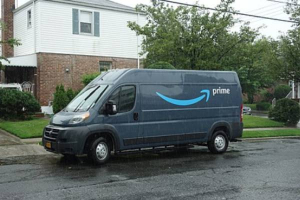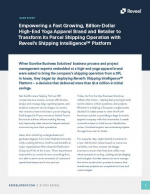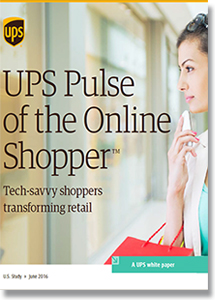2016 UPS Pulse of the Online Shopper
The latest UPS Study shows avid online shoppers making more than half of their purchases with e-commerce, taking more control with smartphones, and technology is driving retailers to redefine their stores.
Avid online shoppers, who make two or more purchases online in a typical three-month period, are leading a retail revolution.
These consumers are shopping more with their smartphones and demanding a more seamless experience between virtual and physical stores, according to the fifth annual UPS Pulse of the Online Shopper™ study.
This is the first time in the study’s five-year history that more than 50 percent (51%) of all purchases made by respondents are made online, up from 48 percent in 2015.
The shift from traditional in-store shopping to shopping with multiple channels continues. Seventeen percent of consumers plan to shop less in store, shifting time to their electronic devices.
The use of smartphones is up 10 points (to 77%) over the past two years, and retailers are responding. Online shoppers report a better mobile experience with satisfaction up eight points (to 73%) since last year.
Social media’s influence on purchasing decisions is up nine points (to 34%) in the last year with nearly a quarter of respondents (23%) having made purchases through social media sites.
Some traditional online retailers are experimenting with showrooms without inventory to provide consumers with the opportunity to examine products at a physical location before buying them online. One in six shoppers say they have visited such retailers. These locations are finding some initial success with millennials, women and urban shoppers.
While marketplaces such as Amazon and eBay are well-established shopping resources, consumers are turning to them earlier to find the best deals. Thirty-five percent of online shoppers now begin their searches at marketplaces.
Cross-channel transactions, which refer to purchases using in-store and at least one online channel, now account for 38 percent of all purchases (up 2 points). Store-only searches and purchases declined by two points (to 20%). Retailers must create seamless experiences that resonate with how their customers want to shop. Providing detailed product information with good photography, professional and peer reviews, and online access to store inventory (58% find it important) are critical.
Online sales drive significant in-store traffic. Half of shoppers who buy online, ship to a physical store. Of these, 46 percent make additional purchases while picking up their items. A majority of shoppers (60%) also prefer to return items to a store, at which time 70 percent of them make additional purchases. Yet only 36 percent of shoppers say they experience helpful associates when returning items to a store.
Online shoppers report they are using their smartphones in-store for a full range of actions. Nearly 30 percent of shoppers look up product reviews (29%), read product details (28%), compare prices (27%), and access coupons for in-store redemption (27%) regularly (often or most of the time). Just 31 percent of shoppers are aware of in-store beacons. A quarter (26%) of smartphone users are receptive to in-store mobile messaging with Urban shoppers (37%) and millennials (36%) being even more receptive. However, more than four in ten smartphone users are neutral toward the idea of in-store mobile messaging.
Free shipping continues to be the most important factor driving customer satisfaction when checking out online (73%), although consumers are willing to pay a premium for faster delivery. Half of shoppers (50%) would pay for faster shipping for personal reasons, such as birthdays and holidays.
Home delivery is still the preferred location to receive packages, although more consumers are embracing alternate delivery locations. Preference for alternate delivery locations grew nine points (to 35%) in the last two years. More than half of shoppers are interested in an alternate delivery location with extended hours and lower fees.
What’s Related




Favorites





